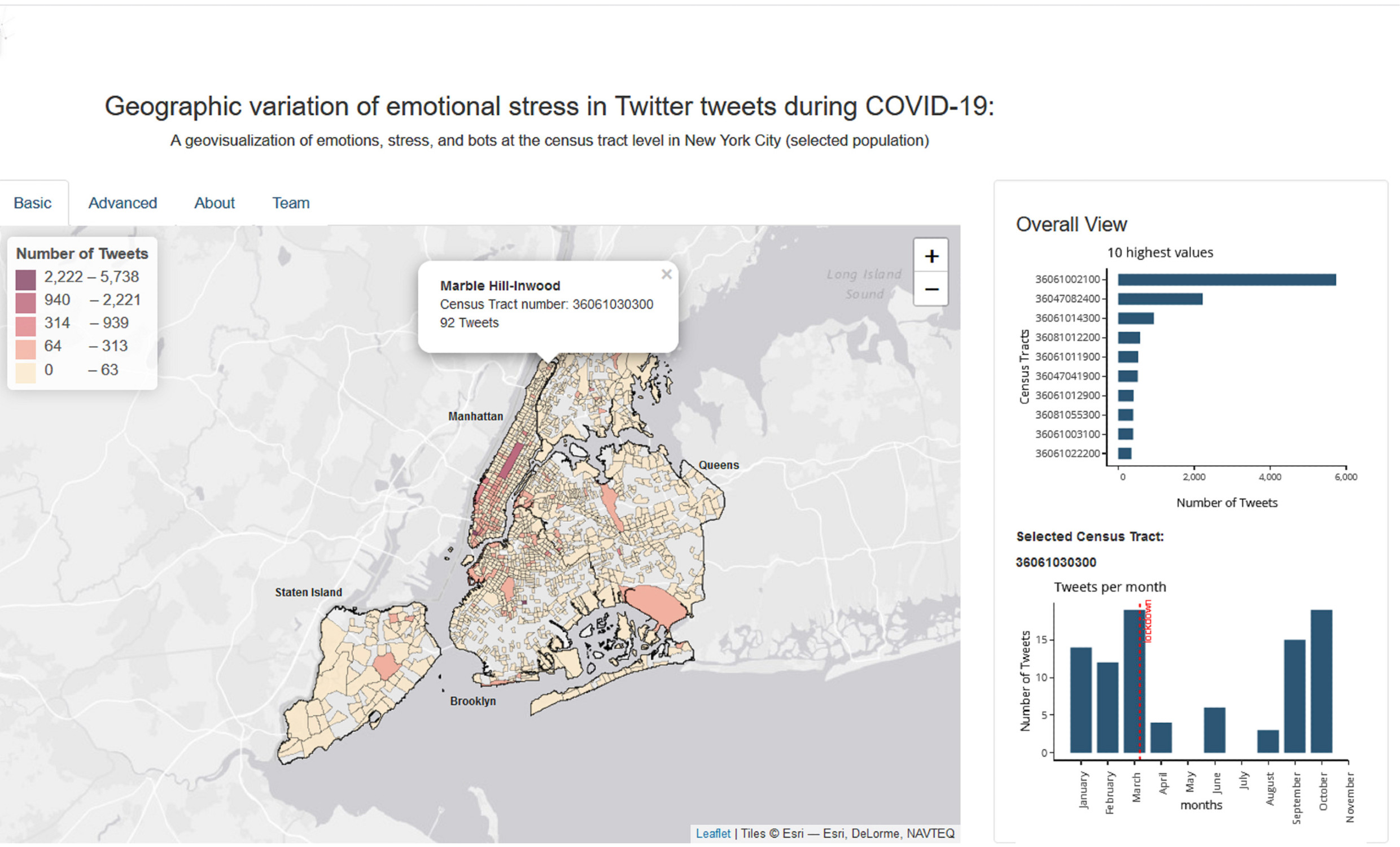New Publication
Real-time geospatial surveillance of localized emotional stress responses to COVID-19: a proof of concept analysis
Health and Place
https://doi.org
givauzh.shinyapps.io/NYC_tweets/
.jpg)
Tamar Edry, Nason Maani, Martin Sykora, Suzanne Elayan, Yulin Hswen, Markus Wolf, Fabio Rinaldi, Sandro Galea, Oliver Gruebner
The COVID-19 pandemic has highlighted the need for improved disease surveillance efforts to guide local responses. These surveillance efforts stand to contribute to the detection and mitigation of viral spread, but also for the detection, and mitigation of the chronic health conditions that are also increasing in parallel with the spread of the virus. Among these, emerging evidence suggests that there will be substantial mental health consequences of the COVID-19 pandemic (Ettman et al., 2020a; Lima et al., 2020). Far from being felt equally, the mental health burden has fallen most on those with the least means (Ettman et al., 2020b). Although effective approaches do exist to treat the emotional toll of the pandemic, there are limited tools to document burden in near real-time. In order to fill that void, we aimed to build a conceptual framework, or a road map, for the use of geo-located social media data, e.g. Twitter, in tracking emotional responses across time and space. The main innovations of the framework include the syntheses and integration of an emotion detection tool to geospatial and temporal analyses, filtering out automated bot tweets and allowing the full exploration of their spatial activity, contextualization with social and physical environments, and offering an on-the-fly hotspot analysis of emotional expressions. A system based on these elements could prove to be beneficial to governments or NGOs, health practitioners, and other stakeholders to prepare for targeted health interventions where they are needed the most.
Social media analyses have emerged as a means to examine population level mental health. Twitter in particular has been shown to be an effective platform for the detection of mood and affective states (Hswen et al., 2018) and has been suggested as a way to identify populations in need following natural or human-made disasters through the use of automated emotive analysis, particularly when combined with aggregated geolocation (Gruebner et al, 2016, 2018). However, the use of such data is complicated by automated social media activity (in particular “bot” accounts), which can account for a disproportionate amount of social media posts, particularly around contested or politically sensitive topics, where political actors seek to sow confusion or panic (Shao et al., 2018). Other than influencing political support, numerous malicious applications have been associated with social bots, such as spreading rumours and conspiracy theories, promoting terrorist propaganda and recruitment, and manipulation of the stock markets (Varol et al., 2017).
We investigated the possibility of an anonymized geospatial analytics and surveillance system that illustrates our main concepts and allowing for the assessment of 1) emotional stress responses of Twitter content, 2) automated bot like behavior, and 3) spatial hotspots of emotional stress, and present these in interactive and dynamic maps by census tract over time.
As a proof of concept, we used the EMOTIVE (Sykora et al., 2013) and Stresscapes (Elayan et al., 2020) tools to categorize emotions and overall stress of tweets in a sample dataset of Twitter users geo-located in NYC between January 1st and October 23, 2020. The data consists of 34,140 geo-tagged tweets from 2,204 users who were originally identified during Superstorm Sandy in New York City (NYC) in 2012, with an average of 15.49 tweets per user in 2020. Emotions and stress found in tweets were calculated as proportions of all tweets (number of tweets with a specific emotion or stress indication divided by all tweets) at census tract level per month. Botometer v.3 (Yang et al., 2019) was used to identify potentially automated Twitter accounts. We used the Moran's I (1950) statistic to identify spatial hotspots of above average emotions or stress identified at the census tract level per month.
We incorporated this approach into a web-based geo-visualization tool that can depict geographic clusters of negative emotion or stress over time in accordance with the spread of the COVID-19 outbreak, allowing users to toggle to identify specific emotions identified, or negative emotions in general, and to identify the extent to which bot accounts are the source of that emotion by adjusting bot detection parameters (Fig. 1).